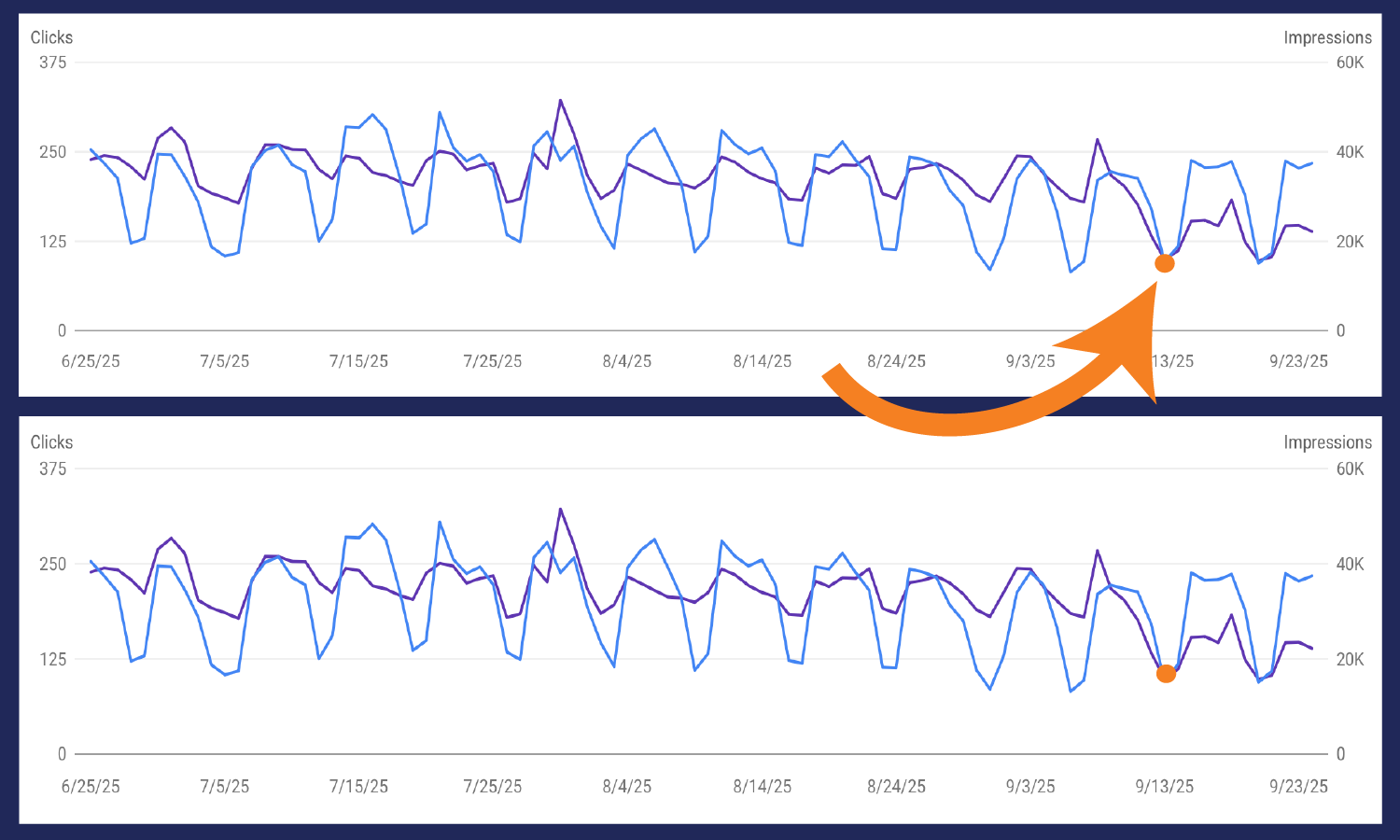GOOGLE SUNSETS THE ”&num=100” PARAMETER
The affects on SEO data, and how it acts as an important reminder for Marketers
September saw a big change in SEO data that caused alarm bells to sound for anyone who pays attention to site vitals. Across the web, spanning industries and interests, sites saw a decrease in impressions, but why? Today we will be diving into the changes that Google made to cause this decrease, the impact it has had on site data and why it is important to zoom out when assessing problems.
OUR FIRST DISCOVERY
The first client of ours where we noticed this drop in impressions, just happened to be a client that we had made site changes on the day before the drop. Which, as you can imagine, led to an “oh sh*t moment” for us. Overnight impressions were down by 30%, not just on the services pages we had made the changes to, but across the site, including the homepage. Now, the changes we made weren’t small, but they should not have caused a 30% decrease in impressions. Here lies our first red flag.
Our initial reaction was to revert the site changes we made or at least scale back. However, we also noticed that despite our drop in impressions, our clicks remained consistent and our position improved. Red flag number two.
This is where we had the important self reminder to zoom out. After we took a step back from this initial client, we quickly saw that the majority of our clients across industries had also experienced a drop in impressions at the same time. Taking a second step back showed us that sites everywhere saw similar decreases and the SEO Community was already buzzing with people questioning this change.
THE SOURCE OF THE IMPRESSION DROP
According to Search Engine Land, 87% of sites saw a drop in impressions. The fact that we saw this drop right after we made site changes for our client was purely a coincidence. Good thing we didn’t have a knee jerk reaction and start reverting all of our changes!
So what actually happened to cause such a drop for all these sites?
Google quietly sunsetted the ”&num=100” Parameter around September 11th.
This parameter originally allowed 100 search results to show for one query on a single SERP page.
Reporting tools, like SEMRush used this parameter to efficiently and cost effectively gather and report data. Before this change, SEO platforms could fetch up to 100 results in a single query using the &num=100 parameter. Now, they can only grab 10 results per query, which forces them to make 10 separate requests to Google for the same amount of data.
This change has caused a significant disruption in tracking across reporting tools and Google Search Console.
WHY THIS MATTER FOR PROFESSIONALS
The most glaringly obvious change to SEO professionals’ site data is the drop in impressions.This isn’t because fewer people are searching, but because Google’s change removed what are now understand to be “bot impressions.”
While tools like SEMrush didn’t directly create impressions in the same way a human searcher does, their large-scale scraping activity inflated impression counts by surfacing lower-ranking pages that real users rarely saw. The result was that sites appeared to be getting more impressions than they truly were. Yikes! Now that these tools can’t use “&num=100”, those impressions are gone.
Though the idea that bots and scraping could affect impressions was always something that was acknowledged by professionals, the extent to which it inflated the impressions is eye opening. The silver lining being, now we (hopefully) are seeing a more accurate representation of user search volume and site ranking.
HOW SUNSETTING THE “&num=100” PARAMETER IS AFFECTING SITE DATA
Impressions drop: As we said before, the most obvious change is the noticeable decline in impressions. We have seen reports of impressions dropping as much as 60% and Search Engine Land observed that “77.6% of sites lost unique ranking terms”.
Clicks consistent: Despite the drop in impressions, clicks remain relatively steady. That’s because the majority of clicks come from the first page of results, and those user interactions are unaffected by the parameter change.
Position Increasing: average position metrics are improving, but not necessarily due to better rankings. With fewer lower-ranking impressions being counted, the data skews upward, making it look like performance has improved when in reality the reporting method has just shifted.
WHAT DOES THIS MEAN FOR SEO EXPERTS
At this point, Marketing tools like SEMRUSH have put out statements acknowledging the situation, reassuring customers that the most important data is intact and they are looking into ways to adjust their systems to keep up with Google’s changes, but no updates have been made yet. Oka, cool. That is for the use of the marketing tools themselves, but what about how to manage your site with this very new landscape. .
Now what about
So, at this time, we advise marketers and SEO experts to do three things.
Set a New Baseline
Since the way impressions and positions are being measured has changed, the first step is to establish a new baseline. Marketers should note that comparisons to pre-change data won’t be apples-to-apples, and moving forward, performance should be measured against the updated reporting standards.
Manage Expectations
It’s important to communicate these shifts to clients, leadership, or stakeholders. Explain that drops in impressions and jumps in average position are tied to Google’s change, not necessarily actual user performance shifts. Setting this context helps prevent misinterpretation of results.
Monitor Trends
While the raw numbers may look different, trends over time are still valuable. Keep monitoring for consistent movement in impressions, clicks, and positions relative to the new baseline, and watch for genuine performance changes that stand out from the reporting adjustments.
WHAT WE HAVE LEARNED
Google can make changes quickly and quietly that have lasting effects on data. The removal of the ”&num=100” parameter isn’t the first and it won’t be the last. This update was a good reminder that not every sudden drop in a metric means something is broken, sometimes it’s the way data is being counted that shifts. By zooming out, checking trends across multiple clients, and staying connected to the SEO community, marketers can separate real performance issues from reporting noise and make smarter, steadier decisions in the face of change.




